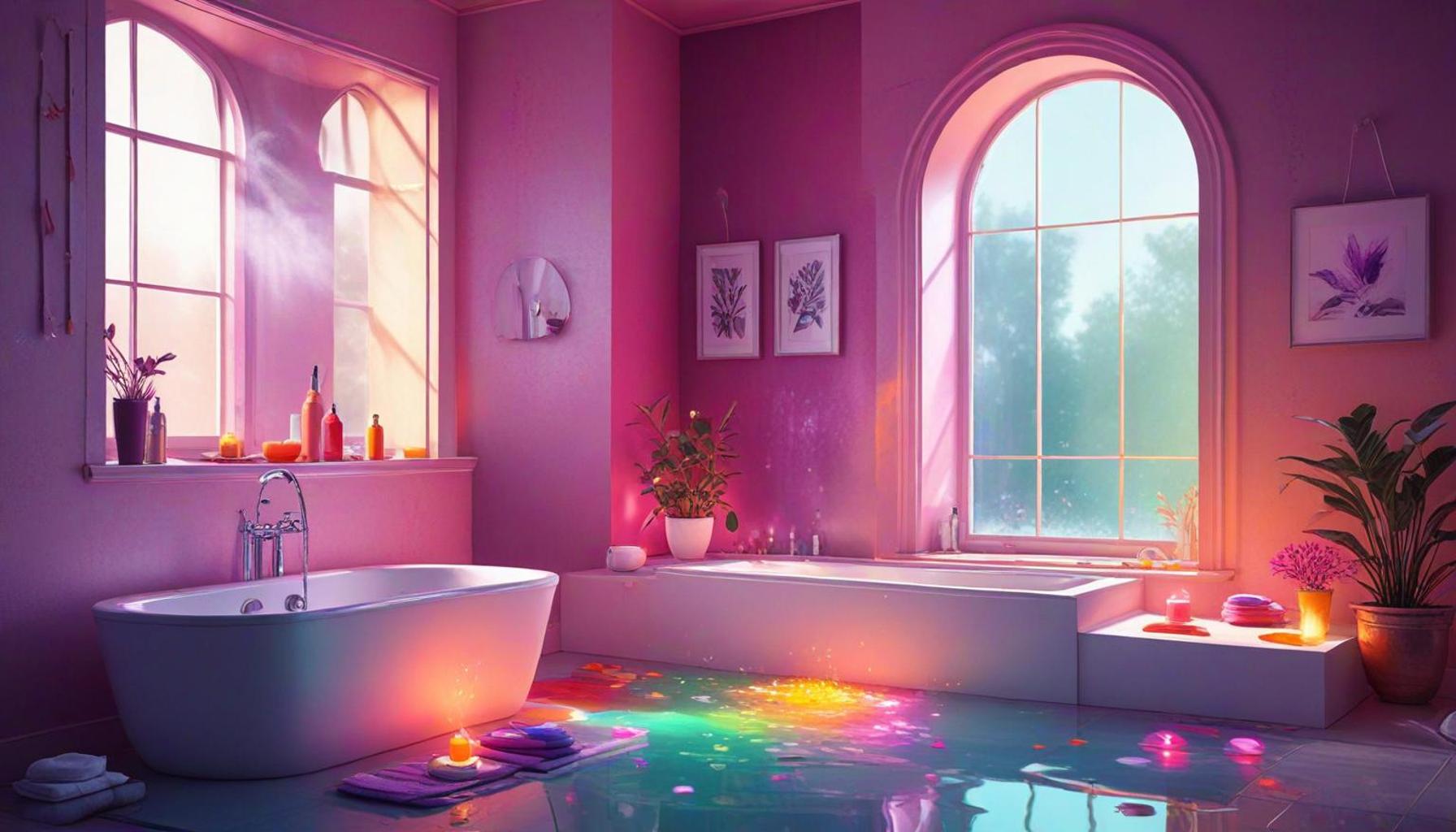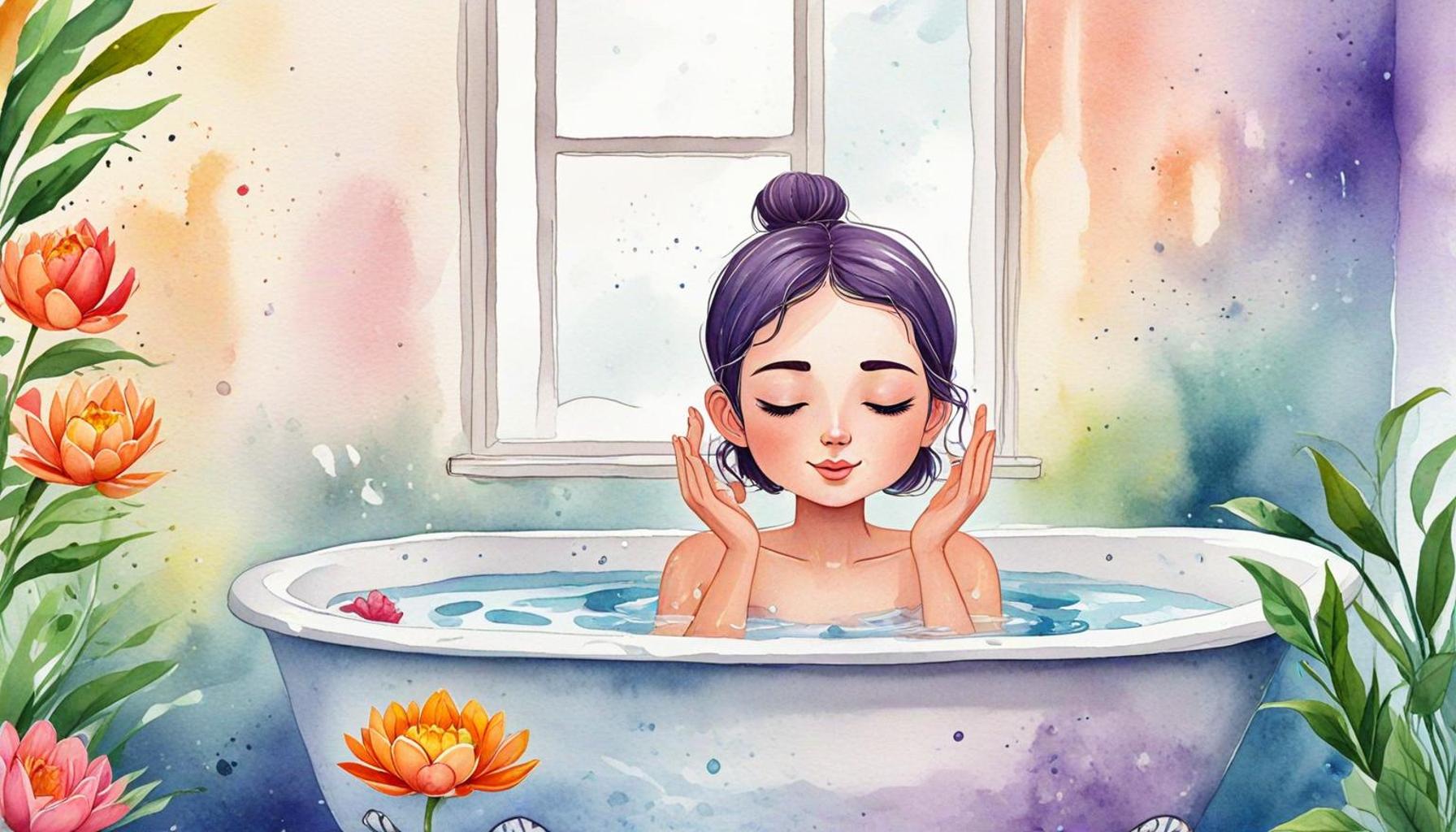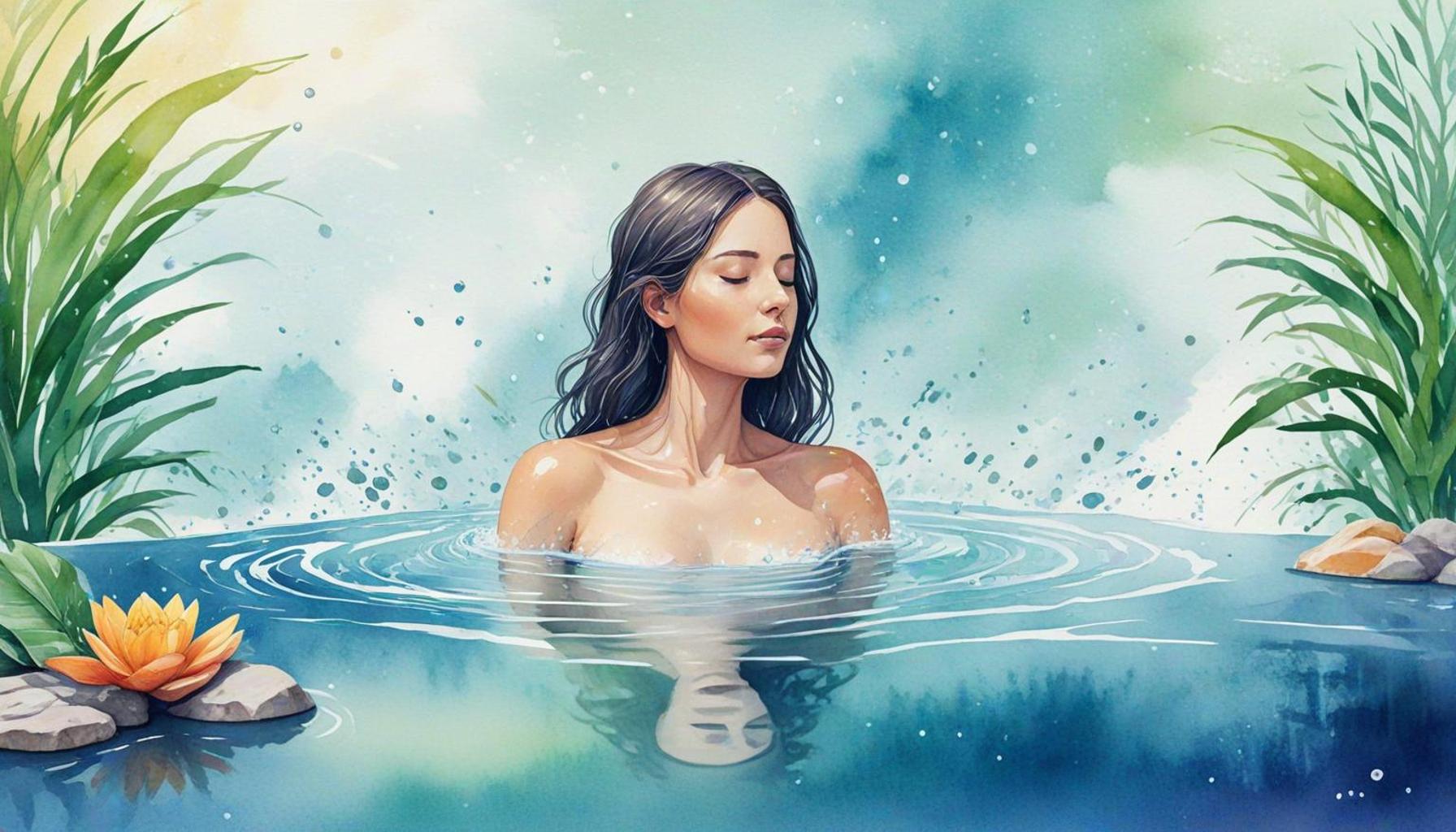Exploring Sensory Awareness Through Color and Lighting in Bath Meditation

Understanding the Role of Color and Light in Bath Meditation
In today’s fast-paced society, where stress often becomes a constant companion, bath meditation stands as a powerful refuge for individuals yearning for peace. This practice intricately weaves together the sensory experiences of color and light, creating an oasis of serenity that can profoundly impact one’s mental and emotional health. By engaging with these elements, bath meditation transcends traditional relaxation techniques, leading to a richer, more transformative experience.
Color Psychology in Meditation
The influence of color on mood and emotion is a field well-studied within psychology. Each color activates different emotional responses; for example, blue, often associated with tranquility, can help lower stress levels and promote serenity. This makes it an ideal choice for a calming bath environment. Conversely, yellow radiates warmth and happiness, invoking feelings of cheerfulness and inspiration. By strategically incorporating these colors into your bath meditation, whether through colored bath bombs, essential oils, or surrounding decor, you can cultivate the specific emotional atmosphere you desire.
Lighting Techniques for Enhanced Relaxation
Lighting plays a crucial role in establishing the ambiance for any meditative practice. Soft, ambient lighting is essential for creating a serene atmosphere. Consider using candles that emit gentle light or low-wattage bulbs that mimic natural sunlight. In contrast, vibrant lighting can stimulate energy and invigorate the mind, making it suitable for morning meditations or rejuvenating bath sessions. Integrating colored filters or light projectors can also redefine your bath experience, creating visuals that enhance emotional states and mental clarity.
Emphasizing Cultural Influence
In countries like Nigeria, cultural influences play a significant role in meditation practices. Traditional colors, rich in meaning and history, can heighten the meditative experience. For instance, the use of earthy tones represents stability and connection to the natural world. Moreover, natural light—whether from soft candlelight or the warm glow of sunset—offers a grounding effect, allowing individuals to connect with their roots and heritage. This cultural nuance adds depth to bath meditation, transforming a simple practice into a meaningful journey of self-exploration.
As you delve into the art of bath meditation, consider how your surrounding environment—including the interplay of color and light—can significantly accentuate your experience. Embrace this sensory exploration, and you may find that it opens new pathways toward relaxation and mindfulness, bringing clarity and rejuvenation to your life.

RECOMMENDED: Check out this similar article
Harnessing Color for Inner Harmony
As you embark on the exciting journey of bath meditation, the role of color becomes pivotal in enhancing your experience. Color is not merely a visual element but a profound tool for emotional and mental state modulation. This concept, known as color psychology, explores how different hues can elicit specific feelings and influences within our minds. In the context of bath meditation, using strategic colors can enhance relaxation, reflection, and rejuvenation.
Consider the following color choices and their psychological effects during bath meditation:
- Blue: Represents calmness and tranquility, ideal for easing anxiety.
- Green: Symbolizes growth and renewal, encouraging a sense of balance.
- Purple: Often associated with spirituality and creativity, it can deepen the meditative experience.
- Pink: Evokes feelings of love and compassion, fostering self-acceptance.
- White: Conveys purity and clarity, aiding in mental clarity and focus.
These colors can be incorporated through various means—bath salts dyed in vibrant hues, the color of candles used during meditation, or even the backdrop of your bathing space. A great practice might involve visualizing these colors enveloping you as you soak in the warm water, allowing their energy to harmonize your thoughts and emotions.
Lighting and Its Impact on Mood
Similar to color, the lighting in your bath meditation environment can remarkably influence your state of mind. Lighting creates not only visibility but also mood, thereby affecting how you perceive the entire meditation process. A well-lit space can energize you, while dimmer settings can lead to deeper relaxation. Here are some effective lighting strategies to consider:
- Use Soft Candlelight: The flicker and warmth of candles can create a comforting atmosphere, perfect for tranquility.
- Warm Bulbs: Choose low-wattage, warm-toned bulbs to mimic the warmth of sunlight, instilling a sense of well-being.
- Natural Light: Positioning your bathing area to capture the gentle glow of the morning or evening sun can invigorate and refresh your spirit.
- Colored Light Filters: Experimenting with filters can introduce vibrant colors into your space, aligning the environment with your mood.
In Nigeria, many individuals find themselves drawn to natural and earthly tones. The use of natural light draws from traditional cultural practices, allowing one to connect deeply with the essence of nature. Understanding the relationship between color and lighting not only enhances your bath meditation but also invites deeper self-awareness and mindfulness. With careful consideration of these sensory elements, your meditation practice can be transformed into a holistic experience that nurtures the mind, body, and soul.
| Category | Insights |
|---|---|
| Color Psychology | Colors can evoke emotions and facilitate deeper relaxation during meditation sessions. |
| Lighting Effects | Natural vs. artificial lighting influences mood and can enhance the sensory experience. |
| Mindfulness Techniques | Integrating colors and lighting in breathwork promotes heightened sensory awareness. |
| Environmental Factors | Creating a soothing environment with colors and lights can lead to more profound meditation effects. |
Exploring sensory awareness in bath meditation emphasizes the significance of color and lighting as tools for enhancing relaxation and mindfulness. Through the integration of color psychology, individuals can learn how specific hues can impact their emotional state, thus deepening their meditative experience. For instance, variations of blue and green are known to instill calmness, while yellows may stimulate joy. Furthermore, the role of lighting effects cannot be understated; natural light has been shown to improve mood and increase feelings of connection to the environment, while soft, dimmed lighting can create an intimate atmosphere conducive to introspection. The coexistence of mindfulness techniques alongside these sensory elements fosters a robust practice, encouraging practitioners to fully immerse themselves in their surroundings and promote a greater understanding of their sensory perceptions.By addressing how environmental factors come into play, this exploration can inspire readers to create their own personalized bath meditation spaces, tailored precisely to their sensory needs. Integrating these elements not only enhances the experience but also opens the door to self-discovery and emotional healing during meditative practices.
YOU MAY ALSO LIKE: Read read another article
Integrating Sound and Aromatherapy for a Complete Experience
In addition to color and lighting, two other crucial elements contribute to the sensory landscape of bath meditation: sound and aroma. Both aspects can intensify your meditation practice, creating a harmonious environment where all senses are engaged. This multifaceted approach not only enhances relaxation but also deepens your connection to the present moment.
Let’s explore how to effectively integrate sound and aromatherapy into your bath meditation:
Incorporating Sound for Enhanced Mindfulness
Sound can significantly impact your mood and focus during bath meditation. The right audio backdrop can help drown out distracting noises, allowing you to immerse yourself fully in your practice. Here are some effective sound options to consider:
- Nature Sounds: The gentle sound of flowing water, birds chirping, or rustling leaves can create a serene atmosphere, evoking the tranquility of nature that resonates deeply within.
- Soft Instrumentals: Calming music, such as soft piano or acoustic guitar melodies, can support relaxation and encourage deeper mindfulness.
- Guided Meditations: Consider using recordings that lead you through meditation practices designed specifically for bath environments, reinforcing relaxation and focus.
- Chanting or Mantras: Vocal sounds that resonate with personal or spiritual significance can evoke a profound sense of connection and peace, enhancing the meditative experience.
In Nigeria, many individuals are already familiar with the soothing sound of traditional drumming or local folk melodies, which can also serve as a beautiful addition to your meditation practice. Leveraging culturally relevant soundscapes can create an emotional resonance, connecting you to your heritage while meditating.
Aromatherapy: Engaging Scent to Enhance Sensory Awareness
Scent can significantly influence our emotions and memory, making it an essential element to integrate into bath meditation. The infusion of specific aromas can enhance relaxation, boost mood, and evoke pleasant memories. Consider these popular essential oils for your meditation:
- Lavender: Known for its calming properties, lavender promotes relaxation and helps alleviate stress, making it an ideal companion for a soothing bath.
- Eucalyptus: This invigorating scent aids in clearing the mind and promoting feelings of rejuvenation, perfect for unwinding after a busy day.
- Ylang-Ylang: Emitting a floral aroma that encourages a sense of well-being, this oil promotes emotional balance.
- Frankincense: Often used in spiritual practices, its grounding scent can enhance meditation and invite a deeper level of reflection.
In Nigeria, indigenous herbal infusions, such as those derived from neem, can add a unique and culturally rich element to your meditation. Incorporating locally sourced scents and herbs fosters a deeper connection with your environment and traditional practices.
To incorporate aromatherapy, consider using essential oil diffusers, dropping oils into the bathwater, or even lighting incense that aligns with your selected scents. By engaging all your senses—color, light, sound, and aroma—you create an immersive bath meditation experience that not only enhances relaxation but also fosters greater self-awareness and clarity.
ADDITIONAL INSIGHTS: Expand your understanding here
Conclusion: Embracing a Holistic Approach to Bath Meditation
In the journey of exploring sensory awareness through color and lighting, we uncover a rich tapestry of experiences that significantly enhance our bath meditation practices. By intentionally incorporating sound and aromatherapy alongside visual elements, we engage our senses in a multi-dimensional exploration that fosters deeper relaxation and self-discovery.
As we’ve seen, each facet—be it the calming hues that soothe our eyes, the gentle play of light that transforms our environment, or the inviting scents that conjure memories—contributes uniquely to the overall experience. The integration of traditional Nigerian sounds and indigenous aromas enrich this practice, linking us to our cultural roots and holistic healing traditions.
Ultimately, the goal of bath meditation transcends mere relaxation; it aims to cultivate a profound connection to the present moment while fostering clarity and tranquility in our minds. By embracing the interplay between color, lighting, sound, and aroma, we create personalized environments tailored to our emotional and spiritual needs.
In a world that frequently pulls us in countless directions, taking the time to curate our sensory experiences through bath meditation can be a transformative practice. As you experiment with these elements, consider documenting your experiences. This exploration is not only a pathway to relaxation but an invitation to rediscover your sense of self amidst the beauty of your surroundings. Dive deeper, engage fully, and allow your senses to guide you on this enriching journey.



